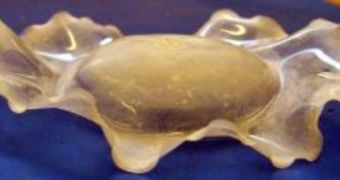Polymers are repeating structural units, or monomers, connected by covalent chemical bonds, present in many natural and artificial materials, from plastics to DNA. Scientists were able to use these polymers to spontaneously create objects that mimic nature's complex shapes.
This is the first time anyone succeeds in programming polymer sheets to bend and wrinkle by themselves, with no outside influence, into pre-determined complex structures. Starting from plain, flat surfaces, Dr. Eran Sharon and his co-workers, Yael Klein and Efi Efrati, at the Hebrew University of Jerusalem Racah Institute of Physics, achieved many surprising shapes and volumes that only nature could produce.
They used flat discs made of a soft gel, which they gradually warmed and then curved and twisted to obtain beautiful shapes, like domes, sombreros and saddles. According to the inventors, a technique for creating three-dimensional objects with precise shapes from a flat polymeric compound could find many industrial applications.
A web of cross-linked polymers that make up the sheets goes through a shrinking process when exposed to temperatures above 33 degrees Celsius (91 F), in correlation with the local polymer density. As this varies, the sheet buckles to relieve the pressure of uneven shrinkage.
Then, it is only a matter of working out what amount of shrinkage would produce a specific structure and of finding the right mixture of polymers. Many devices could benefit from this new technique, which allows the production of various shapes and sizes, according to precise technical specifications.
"Our work enables the creation of highly complex structures, which sometimes would be difficult to manufacture through regular industrial means," said Dr. Sharon.
Further research on the subject could one day lead to a better understanding of the complicated processes that produce nature's most stunning geometrical patterns, like flowers and how they develop in various environments.

 14 DAY TRIAL //
14 DAY TRIAL //